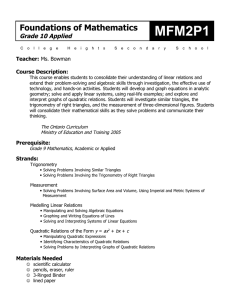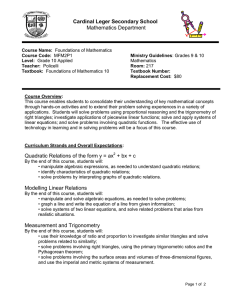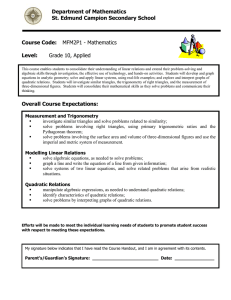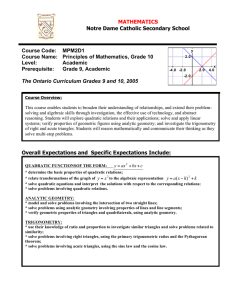Notre Dame Catholic Secondary School Course Code: MFM2P1
advertisement
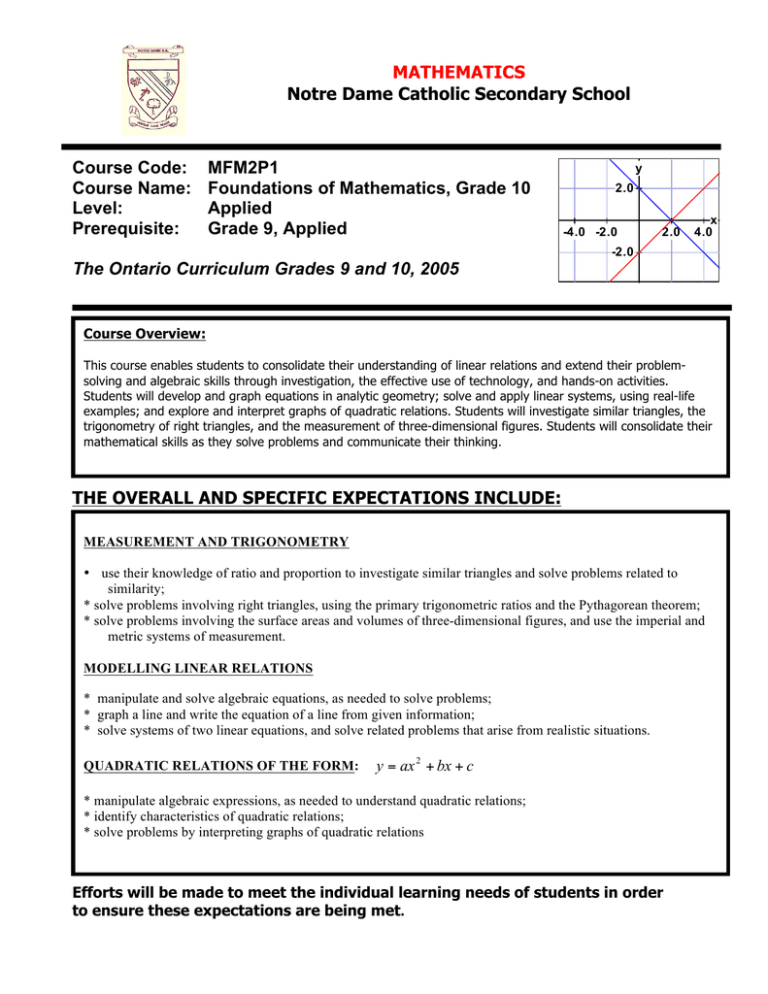
MATHEMATICS Notre Dame Catholic Secondary School Course Code: Course Name: Level: Prerequisite: MFM2P1 Foundations of Mathematics, Grade 10 Applied Grade 9, Applied The Ontario Curriculum Grades 9 and 10, 2005 y 2.0 -4.0 -2.0 2.0 x 4.0 -2.0 Course Overview: This course enables students to consolidate their understanding of linear relations and extend their problemsolving and algebraic skills through investigation, the effective use of technology, and hands-on activities. Students will develop and graph equations in analytic geometry; solve and apply linear systems, using real-life examples; and explore and interpret graphs of quadratic relations. Students will investigate similar triangles, the trigonometry of right triangles, and the measurement of three-dimensional figures. Students will consolidate their mathematical skills as they solve problems and communicate their thinking. THE OVERALL AND SPECIFIC EXPECTATIONS INCLUDE: MEASUREMENT AND TRIGONOMETRY • use their knowledge of ratio and proportion to investigate similar triangles and solve problems related to similarity; * solve problems involving right triangles, using the primary trigonometric ratios and the Pythagorean theorem; * solve problems involving the surface areas and volumes of three-dimensional figures, and use the imperial and metric systems of measurement. MODELLING LINEAR RELATIONS * manipulate and solve algebraic equations, as needed to solve problems; * graph a line and write the equation of a line from given information; * solve systems of two linear equations, and solve related problems that arise from realistic situations. QUADRATIC RELATIONS OF THE FORM: y = ax 2 + bx + c * manipulate algebraic expressions, as needed to understand quadratic relations; * identify characteristics of quadratic relations; * solve problems by interpreting graphs of quadratic relations Efforts will be made to meet the individual learning needs of students in order to ensure these expectations are being met. Course Breakdown Resources: Chapter 4 – Linear Systems The course will use a variety of resources and will rely primarily on a package created by the DPCDSB titled TIPS4RM. This package will be distributed to students during the first couple of weeks of the course. This resource and all others assigned to students are the responsibility of the student. Any loss or damage incurred will result in payment for replacement. Chapter 5 – Introduction to Quadratic Relations Evaluation Structure:: Chapter 1 – Similar Triangles Chapter 2 – Trigonometry Chapter 3 – Equations of Lines Chapter 6 – Quadratic Relations of the Form y = ax2 + bx + c Chapter 7 – Surface Area and Volume Knowledge/Understanding 30 % Thinking/Inquiry 20 % Communication 20 % Application 30 % The above is reflected both in the term work (worth 70% of the final mark) and the summative work (worth 30% of the final mark). Summative work consists of the Final Exam (20%) and a Culminating Activity (10%). Evaluation Policy Students will be assessed & evaluated according to the work produced & skills displayed. Methods of providing feedback will include assessing work in process & evaluating completed assignments, tests, co-operative learning activities, simulations and presentations. Peer & self-evaluations will also be utilized. Student marks will be determined by evaluating process & product according to 4 categories & 4 levels. Please see the chart below for specific skills and key words used to determine student competency in the different categories. Level Category Knowledge/Understanding Knowledge of facts & terms Understanding of concepts & relationships • • Thinking/Inquiry Critical thinking skills Creative thinking skills Inquiry Skills • • • Communication Communication of ideas and information Use of symbols & visuals Oral & written communication • • • Level 1: 50-59% Level 2: 60-69% Level 3: 70-79% Level 4: 80-100% -Limited display of knowledge, skills and ability to apply concepts -Some success in displaying knowledge, skills and application of concepts -Considerable display of knowledge skills and ability to apply concepts -Thorough understanding of concepts and ability to communicate, think creatively and apply concepts Application Applications in familiar contexts Transfer of concepts to new contexts Making logical conclusions and predictions Use of technology Making connections • • • • • Feedback will also be provided for student learning skills. Skills like working independently, team work, organization, work habits and homework, and initiative are assessed independently student achievement and will be conducted through the use of a rubric indicating specific criteria to be achieved to receive each of the following letter grades: E –Excellent G – Good S – Satisfactory N - Needs Improvement Other Evaluation Issues § LATE ASSIGNMENTS. Assignments submitted after the Primary Due Date established by the teacher will be accepted with a penalty of 5% § § § § off for the first day late and 2% for subsequent days to a maximum of 10%. This four day Penalty Zone is the maximum time allowed for submissions. The fourth day after the assignment is due is considered the Closure Date upon which no further assignments will be accepted. If the teacher returns the marked assignments within the four day penalty zone, the date of return is considered the closure date. Repeated lateness in submissions indicates poor organization skills and will result in parental contact and will be reflected in the learning skills section of the report card. INCOMPLETE ASSSIGNMENTS Assignments will be graded according to the extent with which they meet the criteria established in the rubric or evaluation structure. MISSED TESTS Tests missed with a legitimate reason will be written within a few days of the student returning from the absence. Student eligibility to write the test and the date of writing will be at the discretion of the teacher in consultation with the department head. CULMINATING ACTIVITIES These activities will be due toward the end of the course. They are valued between 5 and 15 per cent of the final mark and will reflect course material and competencies not otherwise reflected on the final exam. Plagiarism in any form reflects academic dishonesty and will result in a mark of zero for the assignment in question.
